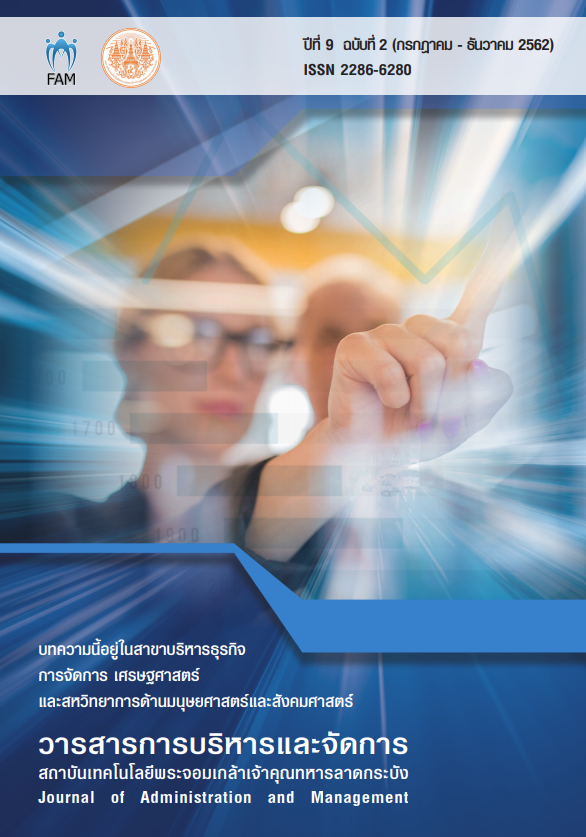HUMAN RESOURCE MANAGEMENT PRACTICES AND PERFORMANCE OF TEACHERS IN THE PRIVATE SCHOOLS OF SARABURI PROVINCE, THAILAND: A DEVELOPMENT PLAN
Main Article Content
Abstract
The Objectives of the research article were to find out the relationship between the HRM practice and the performance of the private school teachers under the provincial education in Saraburi Province, Thailand. A descriptive correlational research design utilizing an adopted questionnaire which was administered to 29 school directors and 564 teachers in private schools. It was revealed that the profile of the teacher respondents was mostly in the age bracket of 25-30 and directors were under 31-35, they were all female, with Bachelor’s degree holder, Thai nationality, with the teaching experience of 1 -5 years and administrative experience of more than 30 years. The extent of HRM practiced were agreed both teachers and directors. They always practiced recruitment and selection, training and development, employee participation, performance appraisal, and compensation and award. It was found out that there was no significant differences of the extent of HRM practices of the teachers. Similarly, there was no significant difference between the extent of HRM practice and profile when grouped according to their profile and no significant difference in the extent of HRM practices of the different districts. Moreover, the performance of the private school teachers in terms of planning, providing teaching materials, and evaluation; learner reinforcement and development; and commitment and communication with the learners revealed was satisfactory. There was no significant difference in the performance of teachers when grouped according to the school districts and also no significant relationship between the extent of HRM practices and performance of teachers in private school. In addition, the problems encountered by the private teachers such as imbalance recruitment of qualified staff, lack of financial support, lack of modern training methods and technologies and unidentified training opportunities. Thus, it can be concluded that HRM practice had no relationship with teachers’ performance.
Article Details
Journal of KMITL Business School is available both online and in printed version.
**All articles or opinions presented in this issue of the Journal of KMITL Business School reflect the thoughts of their respective authors. This journal serves as an independent platform for a variety of viewpoints. Authors bear full responsibility for the content of their articles.**
**All articles published in this journal are copyrighted by KMITL Business School, King Mongkut's Institute of Technology Ladkrabang. The editorial team permits copying or using articles, but a reference to the journal is required.**
References
Delery, J. E., & Doty, H. (2006). Modes of theorizing in strategic human resource Management: Tests of Universalistic,. The Academy of Management Journal, Vol. 39, No. 4, 802-835.
Grote, R. (2012). “Top management team’s vision and human resources management practices in innovative Spanish companies”, The International Journal of Human Resource Management, Vol.19, No. 4, pp. 620-638.
Hiltrop T. (2001),“The multicultural organization”, in: Albrecht,M. (Ed.) International HRM: Managing Diversity in the Workplace, Blackwell, London, pp. 245-260.
Kaler, .D. (2009). “Managing creative people: strategies and tactics for innovation”, Human Resource Management Review, Vol.10, No. 3, pp.313–351.
Mayhew, R. (2019, June 26). Functions and practices in human resource management. Retrieved from https://smallbusiness.chron.com: https://smallbusiness.chron.com/ functions-practices-human-resource-management-59787.html.
McDonough and Shaw B. (2013). “The key role of human resource practices for promotion of creativity and innovation: a Spanish case study”, in: Oliver, J.L.H and Ortiz, M.P (Ed.), Management Innovation, Springer Proceedings in Business and Economics, Springer International Publishing, Spain, pp.119-137.
McLagan, D. (2009). Knowledge Management in Organizations, A Critical Introduction, Oxford: Oxford University Press.
Moore, M. (2017). Chron- 2017 Hearst newspapers. Retrieved June 3, 2017, from What Are HRM Strategies?: http://smallbusiness.chron.com/hrm-strategies-59260.html
Noe (2012). Employee participation developing people business studies and business English/ business case studies. Retrieved from https://businesscasestudies.co.uk: https://businesscasestudies.co.uk/business-theory/people/employee-participation.html
Price, J. (2007). “Global staffing: a review and thematic research agenda”, The International Journal of Human Resource Management, Vol.20, No. 6, pp.1253-1272.
Reddy, K. (2017). What is human resource management – why is it important? Retrieved June 1, 2017, from https://content.wisestep.com/human-resource-management-import ant/: https://content.wisestep.com/human-resource-management-important/.
Stewart, K. (2016). Study.com. Retrieved May 27, 2017, from http://study.com/academy/lesson/strategic-human-resource-management-definition-im portance.html: http://study.com/academy/lesson/strategic-human-resource-manage ment-definition-importance.html
Suparinee Aumporn. (2010), “Research Report in Causal Factors on Administration Affecting Private School Teacher Turnover”, The Journal of Suddhiparitad, Vol.79, pp.188.


